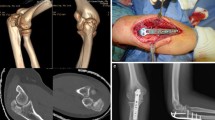Abstract
Purpose
This study compares clinical and functional outcomes of patients with displaced olecranon fractures treated with either tension band wiring (TBW) or a hook plate construct.
Methods
We performed a retrospective review of olecranon fractures operatively treated with either TBW or plate fixation (PF) using a hook plate over a 7-year period. Patient demographics, injury information, and surgical management were recorded. Fractures were classified according to the Mayo system. Measured outcomes included range of elbow motion, time to union, and development of postoperative complications. Mayo Elbow Performance Index (MEPI) scores were obtained for all patients. All patients were followed for a minimum of 6 months.
Results
A total of 48 patients were included in this study, 23 treated with TBW and 25 treated with hook PF. Groups did not differ with respect to patient demographics, Mayo fracture type, or duration of follow-up. Patients undergoing PF had less terminal extension than TBW patients (−8.6° ± 7° vs. −3.5° ± 9.3°, p = 0.036) and a longer time to radiographic union (19 ± 8 vs. 12 ± 6 weeks, p = 0.001). There were no differences in rates of symptomatic hardware, MEPI scores, or other clinical outcomes. Two patients in each group required a second surgery.
Conclusions
TBW and PF of olecranon fractures had similarly excellent functional outcomes in this study. Patients undergoing PF had a longer time to union and slightly worse extension at final follow-up. TBW remains an effective treatment for appropriately selected olecranon fractures and in this cohort outperformed plate osteosynthesis.


Similar content being viewed by others
References
Wolfgang G, Burke F, Bush D et al. (1987) Surgical treatment of displaced olecranon fractures by tension band wiring technique. Clin Orthop Relat Res 224:192–204
Tarallo L, Mugnai R, Adani R et al (2014) Simple and comminuted displaced olecranon fractures: a clinical comparison between tension band wiring and plate fixation techniques. Arch Orthop Trauma Surg 134:1107–1114. doi:10.1007/s00402-014-2021-9
Hutchinson DT, Horwitz DS, Ha G et al (2003) Cyclic loading of olecranon fracture fixation constructs. J Bone Joint Surg Am 85-A:831–837
Hume MC, Wiss DA (1992) Olecranon fractures. A clinical and radiographic comparison of tension band wiring and plate fixation. Clin Orthop Relat Res 285:229–235
Morrey BF (1995) Current concepts in the treatment of fractures of the radial head, the olecranon, and the coronoid. Instr Course Lect 44:175–185
Longo UG, Franceschi F, Loppini M et al (2008) Rating systems for evaluation of the elbow. Br Med Bull 87:131–161. doi:10.1093/bmb/ldn023
Tejwani NC, Garnham IR, Wolinsky PR et al (2002) Posterior olecranon plating: biomechanical and clinical evaluation of a new operative technique. Bull Hosp Jt Dis 61:27–31
Weber BG, Vasey H (1963) Osteosynthesis in olecranon fractures. Z Unfallmed Berufskr 56:90
Helm RH, Hornby R, Miller SWM (1987) The complications of surgical treatment of displaced fractures of the olecranon. Injury 18:48–50. doi:10.1016/0020-1383(87)90386-X
Horne JG, Tanzer TL (1981) Olecranon fractures: a review of 100 cases. J Trauma 21:469–472
Snoddy MC, Lang MF, An TJ et al (2014) Olecranon fractures: factors influencing re-operation. Int Orthop (SICOT) 38:1711–1716. doi:10.1007/s00264-014-2378-y
Chalidis BE, Sachinis NC, Samoladas EP et al (2008) Is tension band wiring technique the “gold standard” for the treatment of olecranon fractures? A long term functional outcome study. J Orthop Surg Res 3:9. doi:10.1186/1749-799X-3-9
Buijze G (2009) Clinical evaluation of locking compression plate fixation for comminuted olecranon fractures. J Bone Joint Surg Am 91:2416. doi:10.2106/JBJS.H.01419
Edwards SG, Martin BD, Fu RH et al (2011) Comparison of olecranon plate fixation in osteoporotic bone: Do current technologies and designs make a difference? J Orthop Trauma 25:306–311. doi:10.1097/BOT.0b013e3181f22465
Edwards SG, Cohen MS, Lattanza LL et al (2012) Surgeon perceptions and patient outcomes regarding proximal ulna fixation: a multicenter experience. J Shoulder Elbow Surg 21:1637–1643. doi:10.1016/j.jse.2011.11.024
Morrey BF, Askew LJ, Chao EY (1981) A biomechanical study of normal functional elbow motion. J Bone Joint Surg Am 63:872–877
Sardelli M, Tashjian RZ, MacWilliams BA (2011) Functional elbow range of motion for contemporary tasks. J Bone Joint Surg Am 93:471–477. doi:10.2106/JBJS.I.01633
Siebenlist S, Torsiglieri T, Kraus T et al (2010) Comminuted fractures of the proximal ulna—preliminary results with an anatomically preshaped locking compression plate (LCP) system. Injury 41:1306–1311. doi:10.1016/j.injury.2010.08.008
Erturer RE, Sever C, Sonmez MM et al (2011) Results of open reduction and plate osteosynthesis in comminuted fracture of the olecranon. J Shoulder Elbow Surg 20:449–454. doi:10.1016/j.jse.2010.11.023
Simpson NS, Goodman LA, Jupiter JB (1996) Contoured LCDC plating of the proximal ulna. Injury 27:411–417
Buijze GA, Blankevoort L, Tuijthof GJM et al (2009) Biomechanical evaluation of fixation of comminuted olecranon fractures: one-third tubular versus locking compression plating. Arch Orthop Trauma Surg 130:459–464. doi:10.1007/s00402-009-0980-z
Author information
Authors and Affiliations
Corresponding author
Ethics declarations
Conflict of interest
None.
Rights and permissions
About this article
Cite this article
DelSole, E.M., Pean, C.A., Tejwani, N.C. et al. Outcome after olecranon fracture repair: Does construct type matter?. Eur J Orthop Surg Traumatol 26, 153–159 (2016). https://doi.org/10.1007/s00590-015-1724-0
Received:
Accepted:
Published:
Issue Date:
DOI: https://doi.org/10.1007/s00590-015-1724-0




